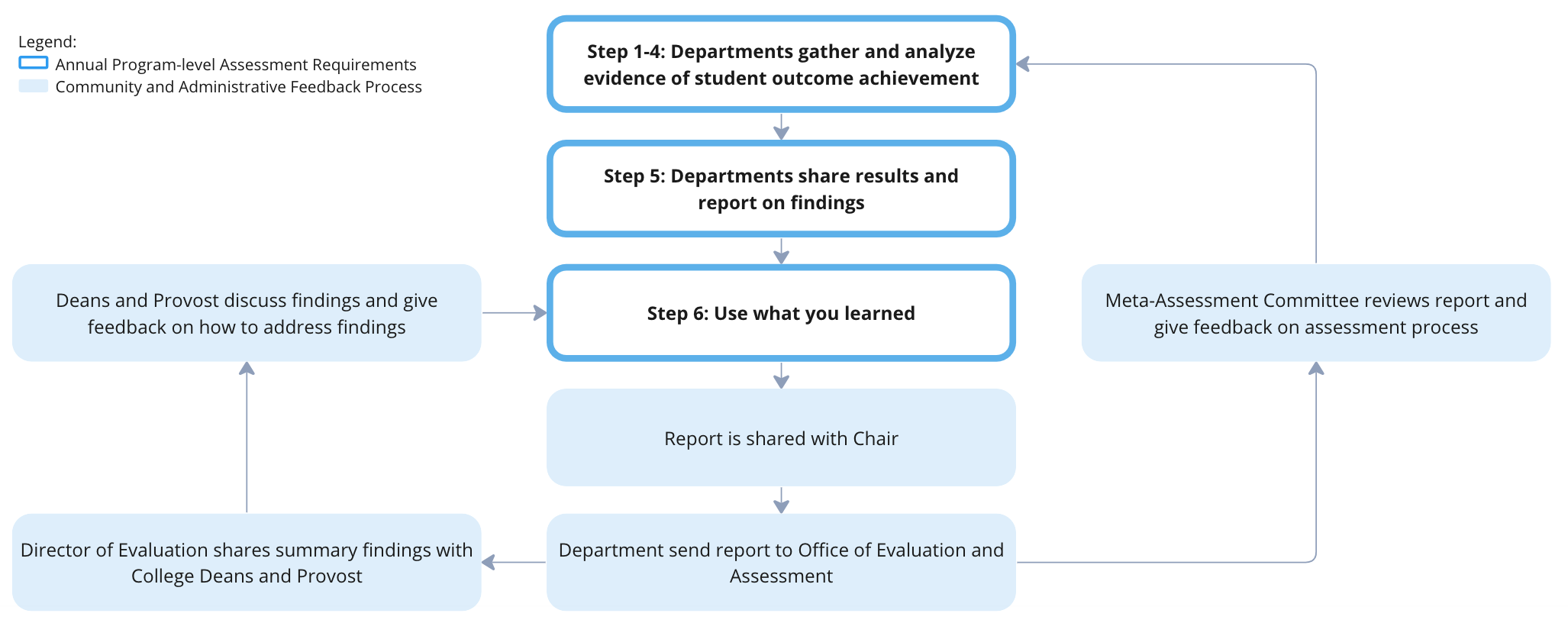Program Level Annual Assessment Steps:
-
Step 1: Identify Outcome(s) to be assessed.
As part of the assessment process, it is important to know where the focus of the assessment should be. As such, a crucial first step is to identify the Student Outcomes that are to be assessed. You have two options here to get you started:
- Option 1 – Collaboratively at the beginning of the academic year, decide on which program-level student outcome(s) will be assessed. The goal is to get through at least one assessment of each student outcome in between Program Reviews.
- Option 2 – Continue to work through the designated student outcome(s) as identified in your program’s long-term assessment plan. The goal is to get through at least one assessment of each student outcome in between Program Reviews.
For more information, the STEP 1 in the Assessment Handbook will provide greater detail, and the Creating Learning Outcomes instructional sheet will help you create student outcomes pertinent to your program. You may also want to reference Bloom's Taxonomy if you are creating or revising student outcomes.
-
Step 2: Providing Aligned Student Experiences to Outcomes
After you have identified a student outcome to be assessed, it is important to "map" that outcome to a specific set of student experiences. These experiences could be purely coursework, tied to specific fieldwork/research, or be a combination. Mapping student outcomes to student experiences will help to identify where assessment of an outcome should occur and at what point in the program. For more information on how to create one, please refer to STEP 2 in the UCR Assessment Handbook. You can also look to the following for additional help:
- Undergraduate Programs
- Student Experience Map Template with Core Competencies
- Student Experience Map Example with Core Competencies
- Student Experience Map Instructions
- Core Competency Inclusion Instructions can be found in the November 16, 2021 Undergraduate Annual Assessment Workshop recording and slides
- AAC&U VALUE Rubric for Core Competencies for additional context
- Graduate Programs
- Undergraduate Programs
-
Step 3: Gather Evidence of Student Achievement of Outcomes
Once the outcomes have been identified and the mapping completed, it is time to collect the evidence (student work). There are Direct and Indirect forms of evidence that may be used for assessing student achievement at the program-level with pros and cons associated with both kinds of evidence. Fortunately, you have options here.
- Option 1 – Obtain student work from all relevant experiences (e.g. more than one course) that demonstrates achievement of student outcome(s). Good option when mastery of student outcomes are demonstrated across multiple courses/experiences.
- Option 2 – Obtain student work from just one relevant experience (e.g. just one course) that demonstrates achievement of student outcome(s). Good option when mastery of student outcomes are demonstrated through just one course/experience, such as a capstone of some kind.
For more information on the different types of evidence and sampling, refer to STEP 3 in the UCR Assessment Handbook.
-
Step 4: Analyzing Evidence
Once all of your student work (student evidence) is collected, it is time to start analyzing the work. This point in the process is where you start to tell the story of how well your students did in achieving a specified outcome. This analysis can be done in two ways:
- Option 1 – Conduct a juried assessment where multiple faculty are involved in the scoring of student evidence. This is a good when evidence comes from multiple courses/experiences, and it always helps in sharing the load.
- Option 2 – One faculty member is responsible for the scoring of student evidence, which is a good option when evidence comes from a single course/experience, but it does place the burden on just one faculty member.
In addition to who carries out the analysis, it is also important to think about the criteria that will be used to analyze the evidence. The most common tool used is a rubric, but you can use any set of criteria so long as it is clear and makes sense to you. As part of this, you should consider if you would like to take a more quantitative or qualitative approach to summarizing your results. For more information on Analyzing Evidence, refer to STEP 4 in the UCR Assessment Handbook. For rubrics, consider looking to the AAC&U VALUE Rubrics (you can also download them directly from our site in PDF Format and an Editable Word Format) and iRubric (you can also create your own in iRubric).
-
Step 5: Documenting and Sharing Results
Once the analysis is completed, it is important to document and share your results. Among other reasons why, this is an opportunity to encourage greater collaboration and provide insight into the strengths of your program in helping students achieve outcomes. a. It is important to share findings with other faculty in your department and use that time to discuss and reflect on the findings. This is primarily done through the UCR Annual Assessment Report. For more information on documenting and sharing your assessment results, please refer to STEP 5 in the UCR Assessment Handbook.
-
Step 6: Using What You Have Learned
The goal of assessment is to find actionable insights into how you might help students meet/exceed expectations. Throughout the entire assessment process, the focus should be on how evaluating achievement of student outcomes will help improve your program, and because this is at the program-level, this should be a collaborative effort. In this final step of the assessment process, you use the information gained from the assessment to identify next steps and make recommendations that are actionable and directly tied to the outcome(s) assessed, and then work towards meeting those recommendations. For more information, please refer to STEP 6 in the UCR Assessment Handbook.
More details on each step can be found below the diagram.
